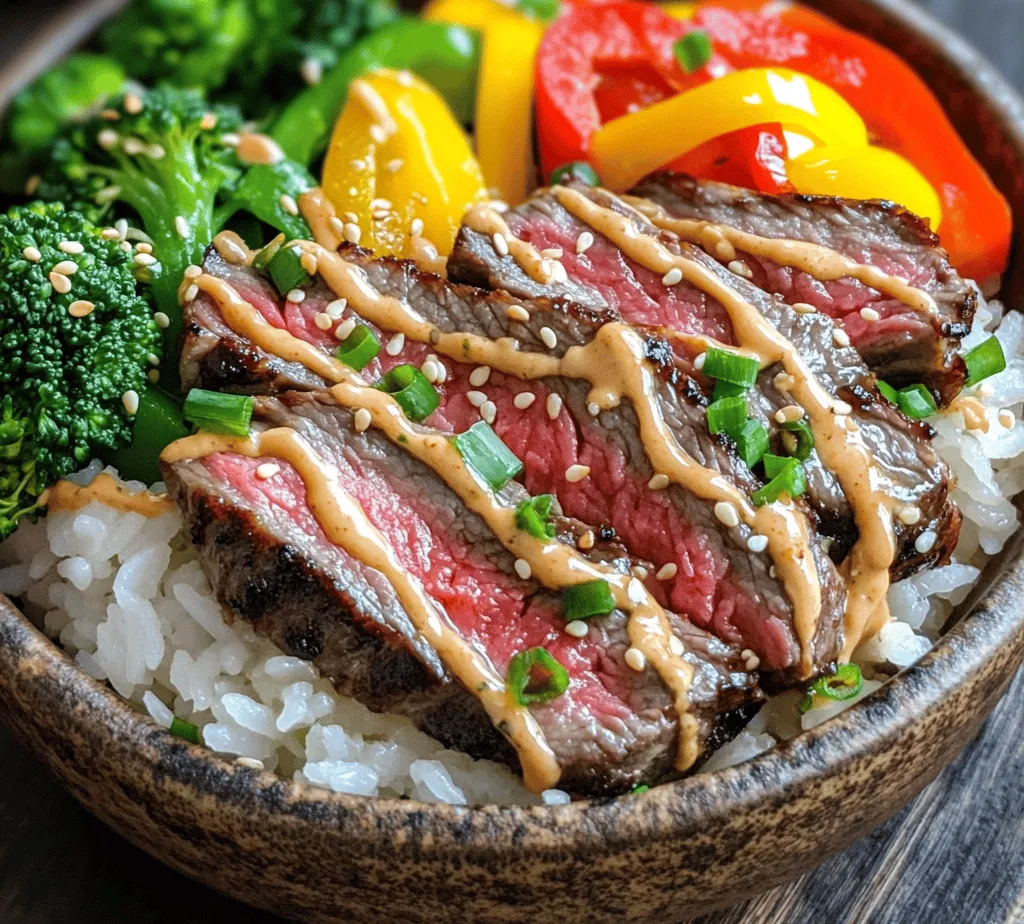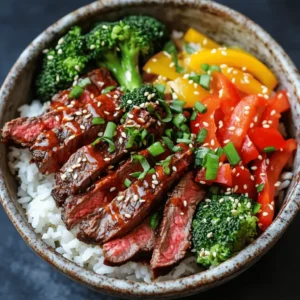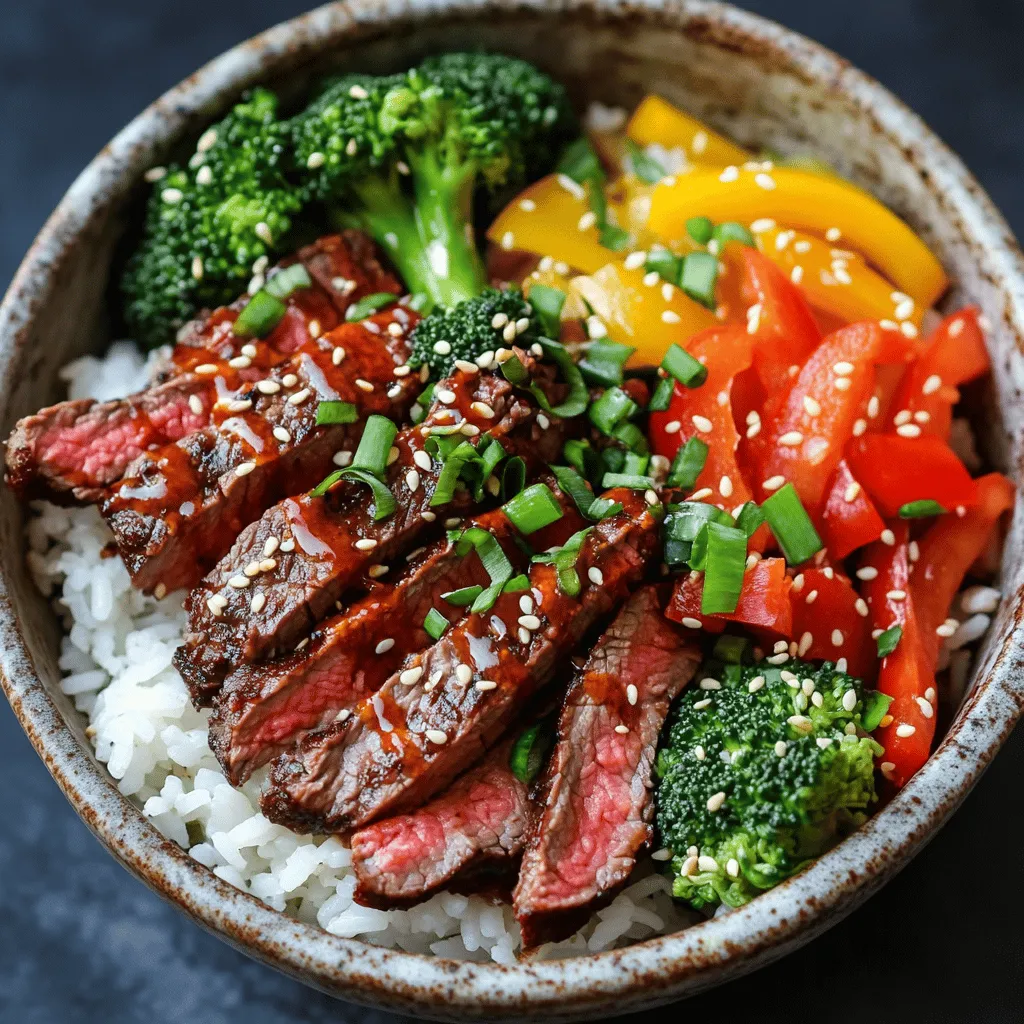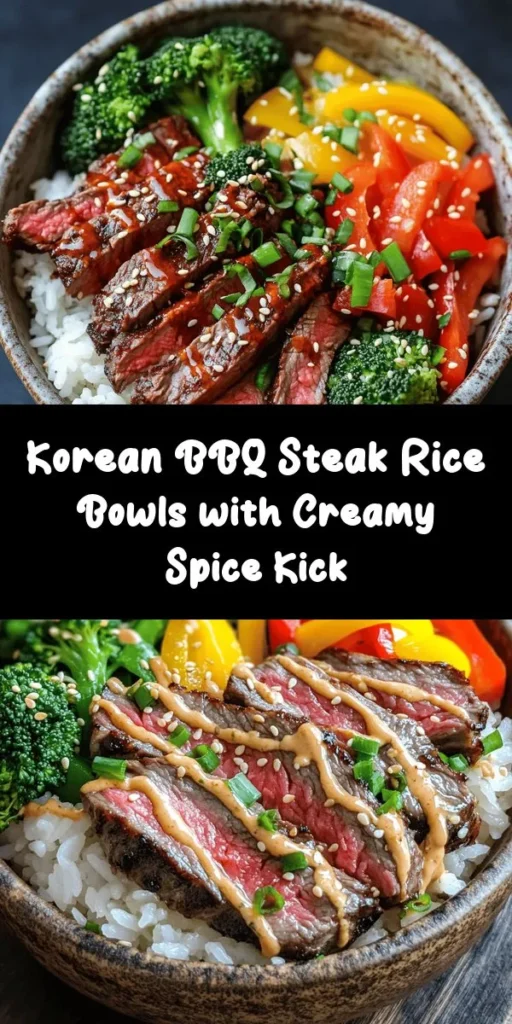Introduction
Korean BBQ is more than just a meal; it’s a vibrant culinary experience that encapsulates the rich culture and traditions of Korea. Originating from the practice of grilling meats over an open flame, Korean BBQ has evolved into a cherished social activity where friends and family gather around a table to enjoy deliciously marinated meats and an array of flavorful side dishes. Its significance in Korean culture is profound, representing hospitality, togetherness, and a love for food that brings people closer.
Among the myriad of dishes that showcase the bold flavors of Korean cuisine, Korean BBQ Steak Rice Bowls with Spicy Cream Sauce stand out as a delightful fusion of textures and tastes. This dish combines tender, marinated steak with fluffy jasmine rice, colorful vegetables, and a creamy sauce that packs a punch. The sweet and savory notes of the marinade, along with the spiciness of the sauce, create a flavor profile that is both satisfying and unforgettable.
Whether you’re preparing a casual family dinner or hosting a gathering with friends, these rice bowls are versatile and accommodating to various tastes. They can be customized with your favorite vegetables or adjusted for spice levels, making them a perfect choice for any occasion.
Understanding Korean BBQ
At the heart of Korean BBQ lies a unique cooking style that emphasizes the art of grilling meats, often right at the dining table. Diners enjoy the interactive experience of cooking their food to perfection, allowing for a communal atmosphere where everyone can participate. This method not only enhances the flavor of the meats through direct heat but also creates an engaging environment where stories are shared and memories are made.
The foundation of Korean BBQ is the marinade. Typically, meats such as beef, pork, or chicken are marinated in a mixture that often includes soy sauce, sesame oil, garlic, and other spices. This not only infuses the meat with rich flavors but also tenderizes it for a melt-in-your-mouth experience. In addition to grilled meats, Korean BBQ is accompanied by an assortment of banchan, or side dishes, which can include pickled vegetables, kimchi, and various salads. These side dishes provide a refreshing balance to the rich flavors of the meats.
Korean BBQ Steak Rice Bowls with Spicy Cream Sauce embody the essence of this culinary tradition. The marinated flank steak is grilled to perfection, then served over a bed of jasmine rice, topped with vibrant vegetables and drizzled with a spicy cream sauce. This dish captures the spirit of Korean BBQ by celebrating bold flavors and textures while being easily accessible for home cooks.
Key Ingredients Breakdown
To create the ultimate Korean BBQ Steak Rice Bowls, it’s essential to understand the key ingredients that contribute to the dish’s delectable taste and texture.
Flank Steak
Flank steak is the star of this dish, chosen for its lean, flavorful qualities. This cut comes from the abdominal muscles of the cow, making it a bit tougher than other cuts. However, when marinated properly and cooked quickly over high heat, it becomes incredibly tender and juicy. The unique texture of flank steak allows it to soak up the marinade, enhancing its flavor profile.
Soy Sauce
A staple in Korean cuisine, soy sauce is essential for marinating meats and adding depth to dishes. Its salty and umami-rich flavor enhances the overall taste of the steak, providing a savory foundation that complements the other ingredients. Look for a high-quality soy sauce to attain the best results in your marinade.
Sesame Oil
Another key ingredient in Korean cooking, sesame oil adds a nutty aroma and flavor that elevates the dish. This oil is often used in marinades and dressings, contributing to the overall depth of flavor in the rice bowls. It also provides a touch of richness that balances the spices in the dish.
Brown Sugar
Brown sugar plays a crucial role in balancing the savory elements of the marinade. Its sweetness caramelizes beautifully during the cooking process, creating a delightful crust on the meat while enhancing the overall flavor. The combination of sweet and savory is a hallmark of Korean BBQ, making brown sugar an indispensable ingredient.
Garlic and Ginger
Garlic and ginger are foundational flavors in Korean cuisine, adding both depth and health benefits to dishes. Garlic contributes a pungent aroma and savory taste, while ginger adds warmth and a slight spiciness. Together, they form a fragrant base that enhances the marinated steak, making each bite flavorful and aromatic.
Jasmine Rice
For this dish, jasmine rice is the preferred choice due to its fragrant aroma and slightly sticky texture when cooked. This rice acts as a perfect canvas, soaking up the flavors from the steak and sauce while providing a satisfying base for the meal. The light and fluffy grains complement the richness of the meat and sauce beautifully.
Vegetables
Incorporating a variety of colorful vegetables not only adds nutritional benefits but also enhances the visual appeal of the dish. Common choices for this recipe may include bell peppers, carrots, and green onions. These vegetables provide crunch, freshness, and a burst of color, making the rice bowls not only delicious but visually enticing as well.
Spicy Cream Sauce
The spicy cream sauce is where the dish truly shines, adding a creamy and zesty kick that ties all the flavors together. Typically made with ingredients like mayonnaise, Korean gochujang (red chili paste), and a splash of vinegar, this sauce can be adjusted to your desired level of heat. The creaminess balances the spiciness, creating a well-rounded sauce that elevates the entire dish.
Marinating the Steak
Marinating the steak is a crucial step that enhances both flavor and tenderness. The marinade penetrates the meat, infusing it with savory and sweet notes while breaking down tough fibers for a more enjoyable texture.
Preparing the Marinade
To prepare the marinade, combine the following ingredients in a bowl:
– ¼ cup soy sauce
– 2 tablespoons sesame oil
– 2 tablespoons brown sugar
– 3 cloves minced garlic
– 1 tablespoon freshly grated ginger
Whisk these ingredients together until the sugar is fully dissolved. The resulting marinade should be aromatic and have a balanced flavor profile, with the saltiness of the soy sauce, nuttiness from the sesame oil, and sweetness from the brown sugar.
Marinating Process
Once the marinade is ready, slice the flank steak against the grain into thin strips to allow maximum flavor absorption. Place the sliced steak in a resealable plastic bag or a shallow dish and pour the marinade over it. Make sure each piece is coated well. Seal the bag or cover the dish, and refrigerate for at least 30 minutes. For optimal flavor and tenderness, marinating the steak for 2 to 4 hours is recommended.
Timing for Marinating
Shorter marination times (30 minutes to 1 hour) will provide a good flavor but may not fully penetrate the meat. On the other hand, longer marination times (up to 4 hours or even overnight) allow the flavors to meld thoroughly and the meat to become more tender. However, be cautious not to marinate too long, as the acidity in the marinade can eventually break down the meat and make it mushy.
Preparing the Spicy Cream Sauce
The spicy cream sauce is what takes these rice bowls to the next level, offering a luscious texture and a burst of flavor that complements the marinated steak perfectly.
Ingredients for the Sauce
To prepare the spicy cream sauce, you’ll need:
– ½ cup mayonnaise
– 1 tablespoon gochujang (Korean red chili paste)
– 1 tablespoon rice vinegar
– 1 teaspoon sesame oil
– 1 teaspoon honey or sugar (optional for added sweetness)
– Salt and pepper to taste
Step-by-Step Preparation
1. In a medium bowl, combine the mayonnaise, gochujang, rice vinegar, and sesame oil.
2. Whisk the ingredients together until smooth and well incorporated.
3. Taste the sauce and adjust the seasoning with salt and pepper. If you prefer a sweeter sauce, add the honey or sugar and whisk until dissolved.
4. For a thicker consistency, you can refrigerate the sauce for about 30 minutes. This step also allows the flavors to meld together beautifully.
Variations of the Sauce
If you want to experiment with different spice levels, consider adjusting the amount of gochujang in the sauce. For a milder version, reduce the quantity or mix in a bit of sour cream or Greek yogurt to cool it down. Conversely, for those who crave more heat, additional gochujang or a splash of sriracha can elevate the spiciness to your liking.
In this first part of the recipe article, we’ve explored the cultural significance of Korean BBQ, dissected the key ingredients, and discussed the critical steps for marinating the steak and preparing the spicy cream sauce. As we move forward, we will delve into the cooking and assembly of the dish, ensuring that your Korean BBQ Steak Rice Bowls with Spicy Cream Sauce become a delectable centerpiece at your next meal. Stay tuned for the exciting conclusion, where we will bring all these elements together for a satisfying dining experience.

Cooking the Steak
Grilling or searing steak to perfection is an art that enhances the overall experience of Korean BBQ Steak Rice Bowls. To achieve the desired doneness, whether you prefer rare, medium, or well-done, follow these expert techniques:
Techniques for Grilling or Searing Steak
1. Choose the Right Cut: For this recipe, flank steak or ribeye are excellent choices due to their flavor and tenderness. Ensure that your steak is at room temperature before cooking, which promotes even cooking.
2. Preheat the Grill or Pan: Heat your grill or skillet over high heat. A well-heated surface ensures that the steak develops a beautiful crust while remaining juicy inside. If using a skillet, add a bit of oil to prevent sticking.
3. Season Generously: Just before cooking, season the steak liberally with salt and freshly cracked black pepper. This enhances the flavor and helps form a delicious crust.
4. Cooking Time: Grill your steak for approximately 4-5 minutes on each side for medium-rare, depending on the thickness. For a perfect medium, aim for 6-7 minutes per side. Use a meat thermometer to check for doneness: 130°F (54°C) for medium-rare, 140°F (60°C) for medium.
5. Searing Technique: If searing, avoid moving the steak too much. Let it sear undisturbed to develop a nice crust. If you’re grilling, you can rotate it 90 degrees halfway through cooking on each side for those attractive grill marks.
Importance of Resting the Steak After Cooking
Once your steak reaches the desired doneness, it’s crucial to let it rest for about 5-10 minutes. This resting period allows the juices to redistribute throughout the meat, resulting in a more flavorful and tender bite. Cutting into the steak immediately will cause the juices to run out, leading to a drier texture.
How to Slice the Steak Properly
To maximize tenderness, slice the steak against the grain. This means cutting perpendicular to the direction of the muscle fibers. When sliced correctly, each piece will be more tender and easier to chew. Aim for ¼-inch thick slices for optimal presentation and enjoyment.
Sautéing the Vegetables
Sautéing vegetables is a crucial step in creating a vibrant and flavorful Korean BBQ Steak Rice Bowl. Here’s how to master the technique:
Cooking Techniques for Maintaining Crunch and Color
1. Use High Heat: Sauté your vegetables over medium-high heat. This quick cooking method keeps them crisp and bright in color while ensuring that they are cooked through.
2. Cut Uniformly: Slice your vegetables (bell peppers, carrots, and zucchini) into similar sizes to ensure they cook evenly. Thin strips or bite-sized pieces work best.
3. Avoid Overcrowding: When sautéing, do it in batches if necessary. Overcrowding the pan causes steam instead of a nice sear, resulting in soggy vegetables.
Discussing Seasoning Choices for Vegetables
Season your vegetables with a pinch of salt and a dash of soy sauce or sesame oil. This enhances their natural flavors and adds an umami kick that complements the steak beautifully. You can also add minced garlic or ginger for an extra layer of flavor.
Importance of Timing When Sautéing
Timing is essential to ensure that your vegetables maintain their crunch while being tender. Start with the hardest vegetables first, such as carrots, and add softer ones, like bell peppers and zucchini, later in the cooking process. A total sautéing time of about 4-5 minutes is ideal for retaining that perfect texture.
Assembling the Rice Bowls
Now that your steak and vegetables are ready, it’s time to assemble your bowls for an enticing presentation.
Step-by-Step Process for Assembling the Bowls
1. Start with Rice: Begin with a generous serving of cooked rice at the bottom of each bowl. Jasmine rice or short-grain rice is an excellent choice for authenticity.
2. Layer the Ingredients: Next, arrange the sliced steak on one side of the rice. Add the sautéed vegetables next to the steak, ensuring a colorful display.
3. Add Additional Toppings: For added flavor and texture, consider topping with pickled radishes or kimchi, which provide a nice contrast to the rich flavors of the steak and sauce.
Suggested Layering Techniques
For enhanced visual appeal, use contrasting colors and textures. For instance, place bright green vegetables next to the deep red steak. The variety will not only look appealing but also create a harmonious balance of flavors in each bite.
Importance of Portion Control and Balance
When assembling your rice bowl, maintain a good balance of proteins, vegetables, and carbs. Aim for equal portions that allow diners to enjoy all components without overwhelming one flavor over another. This balance is key to creating a satisfying meal.
Drizzling with Spicy Cream Sauce
The spicy cream sauce is the star of this recipe, adding a kick that elevates the entire dish.
Techniques for Drizzling Sauce Artistically
1. Use a Squeeze Bottle: For precise drizzling, transfer your sauce to a squeeze bottle. This allows you to control the amount and create beautiful patterns over your assembled bowls.
2. Create Layers: Drizzle the sauce over the steak, then the vegetables. This layered approach not only enhances flavor but also makes the dish visually stunning.
Discussing the Impact of the Sauce on Flavor and Presentation
The spicy cream sauce infuses the rice bowls with a creamy, tangy heat that complements the savory flavors of the steak and vegetables. Its vibrant color also enhances the visual appeal, making your dish look as good as it tastes.
Garnishing and Serving
Garnishing is the final touch that can elevate your dish from ordinary to extraordinary.
Importance of Garnishing
A well-garnished dish is more inviting and visually appealing. It also adds additional flavor and texture, making the meal more enjoyable.
Suggested Garnishing Ideas
– Sliced Green Onions: Sprinkle chopped green onions over the top for a fresh and mild onion flavor.
– Sesame Seeds: Toasted sesame seeds add a delightful crunch and nutty flavor, enhancing the dish’s overall texture.
Serving Suggestions
Consider serving your Korean BBQ Steak Rice Bowls with a side of miso soup or a simple cucumber salad. These light accompaniments can balance the richness of the dish and add freshness to the meal.
Nutritional Information
Understanding the nutritional content of your meal enhances your cooking experience, especially when considering dietary needs.
Breakdown of Nutritional Content
– Calories: Approximately 650-700 calories per serving, depending on ingredient quantities.
– Macronutrients: Each bowl typically contains around 30g of protein, 70g of carbohydrates, and 25g of fat.
– Vitamins and Minerals: The vegetables contribute essential vitamins (like Vitamin A and C) and minerals, while the steak provides iron and B vitamins.
Discussion on Health Benefits
The use of lean protein from the steak, along with nutrient-rich vegetables, makes this dish a balanced option. The high protein content supports muscle maintenance, while vegetables provide dietary fiber and a range of vitamins.
Insight into Portion Sizes and Dietary Considerations
It’s essential to adjust portion sizes based on individual dietary goals. For those looking to reduce carbohydrates, you can serve a smaller portion of rice and increase the vegetable ratio. Likewise, for a low-calorie version, consider using a lighter protein source or adding more leafy greens.
Conclusion
Korean BBQ Steak Rice Bowls with Spicy Cream Sauce is a delightful dish that brings the flavors of Korea right to your kitchen. The process of creating this meal is not only rewarding but also an opportunity to explore the rich culinary traditions of Korean cuisine. Sharing these bowls with friends and family fosters connection and creates memorable dining experiences.
As you enjoy your homemade creation, reflect on the cultural significance of sharing meals and the joy of cooking. Don’t hesitate to experiment with other Korean recipes to expand your culinary repertoire and immerse yourself in the diverse world of flavors they offer. Each dish tells a story and invites you to explore the vibrant culture behind it.



